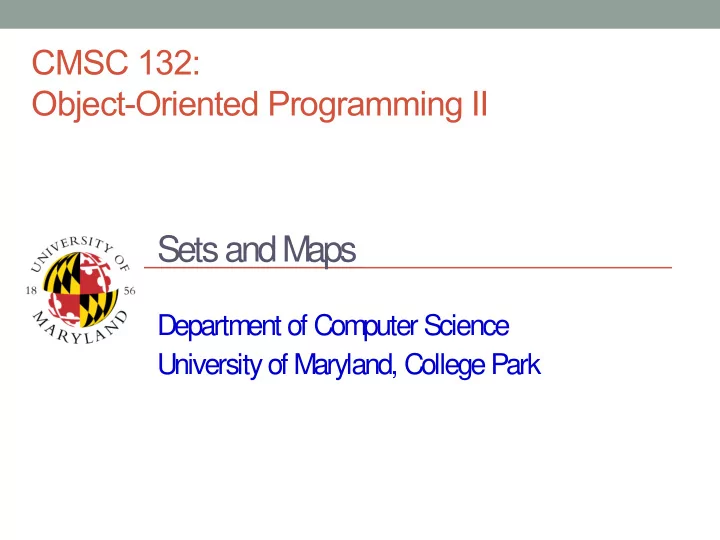

CMSC 132: Object-Oriented Programming II Sets and Maps Department of Computer Science University of Maryland, College Park
Sets • Properties Set A Collection of elements without – duplicates – No ordering (i.e., no front or back) Order in which elements added – doesn’t matter • Implementation goal Offer the ability to find / remove – element quickly Without searching through all – Set B elements Set C
How Do Sets Work in Java? • Finding matching element is based on equals( ) • To build a collection for a class – Need to define your own equals(Object) method – Default equals( ) uses reference comparison ● I.e., a.equals(b) a == b ● a, b equal only if reference to same object – Many classes have predefined equals( ) methods ● Integer.equals( ) compares value of integer ● String.equals( ) compares text of string
Set Concrete Classes • HashSet – Elements must implement hashCode( ) method • LinkedHashSet – HashSet supporting ordering of elements – Elements can be retrieved in order of insertion • TreeSet – Elements must be comparable ● Implement Comparable or provide Comparator – Guarantees elements in set are sorted • Example: See SetsMapsCode
Map Definition • Map (associative array) Unordered collection of keys – For each key, an associated object – – Can use key to retrieve object • Can view as array indexed by any (key) value Example – A[“key1”] = … key1 key2 key3 key4
Map Interface Methods • Methods void put(K key, V value) // inserts element – – V get(Object key) // returns element V remove(Object key) // removes element – int size() // key-value mappings – void clear() // clears the map – boolean containsKey(Object key) // looks for key – boolean containsValue(Object value) // looks for value – boolean isEmpty() // empty map? – Set<K> keySet( ) // entire set of keys – Collection<V> values() // values in the map –
Map Concrete Classes • HashMap – Elements must implement hashCode( ) method • LinkedHashMap – HashMap supporting ordering of elements – Elements can be retrieved in order of insertion • TreeMap – Elements must be comparable ● Implement Comparable or provide Comparator – Elements can be retrieved in sorted order • Example: See SetsMapsCode
Map Properties • Map keys & map objects – Can also treat keys & values as collections ● Access using keySet( ), values( ) – Aliasing ● Each key refers only a single object ● But object may be referred to by multiple keys – Keys & values may be of complex type ● Map<Object Type1, Any Object Type2> ● Including other collections, maps, etc…
Map Implementation • Implementation approaches – Two parallel arrays ● Unsorted ● Sorted – Linked list – Binary search tree – Hash table • Java Collections Framework → uses red-black (balanced) tree – TreeMap – HashMap → uses hash table
Map Hierarchy Map SortedMap AbstractMap TreeMap HashMap Red Interface Black Class LinkedHashMap
Collection & Map Hierarchies Interface (red) Class (black)
Recommend
More recommend